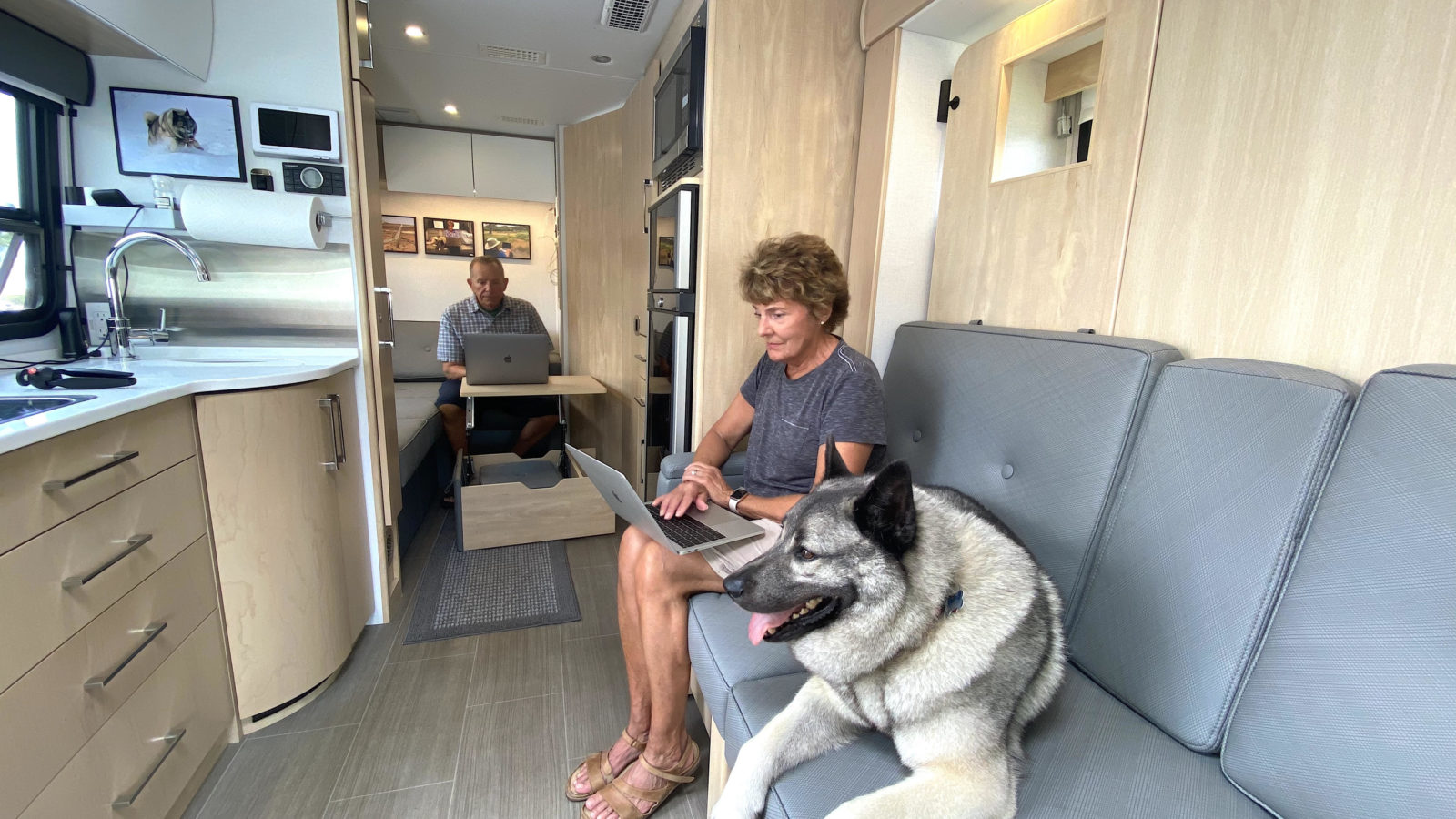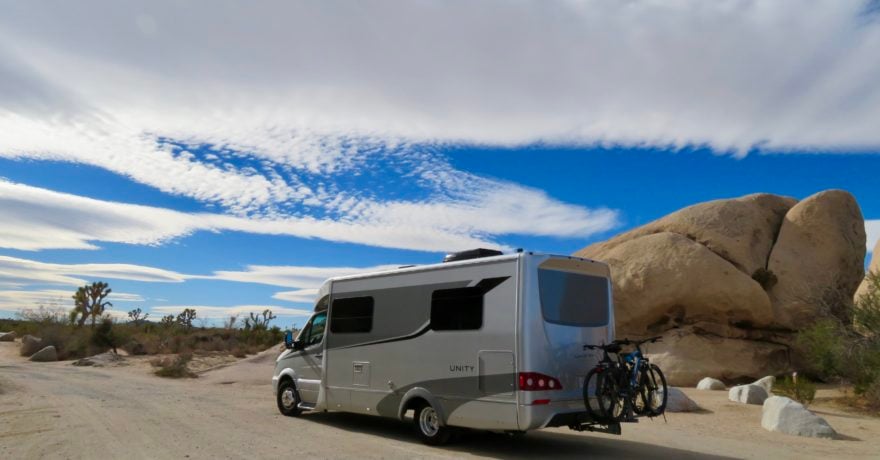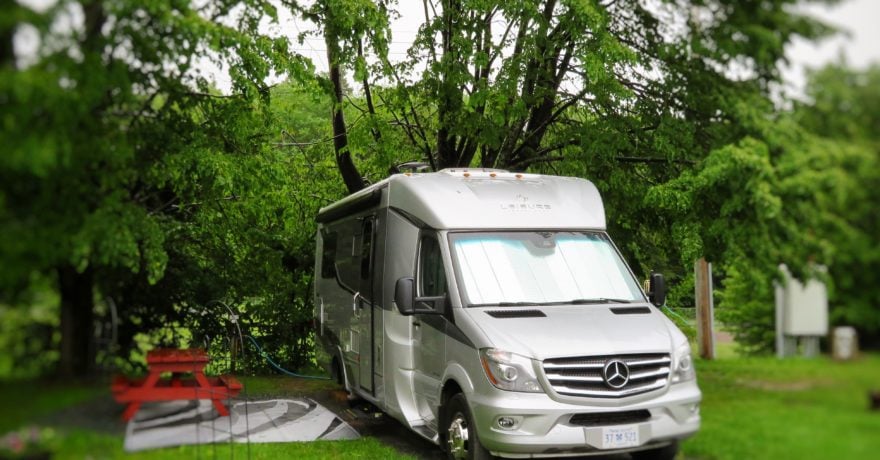With stay-at-home and shelter-in-place orders the new norm as North America reels under the onslaught of the COVID-19 pandemic, many of us are now finding our workplaces expecting us to do our job remotely. And for those used to working outside the home, that can be downright daunting.
Jennifer and I (and Bo, our Norwegian Elkhound) have been working remotely since 2012 and, as RVers who are on the road and work from our Leisure Travel Vans Unity FX almost three-quarters of the time, we have some easy suggestions that will help you navigate all the ins and outs of not being able to physically go into the office while working from your sticks-and-bricks home.

Tip 1: Dedicate a Workspace
The first suggestion we have is to dedicate a specific area for your work where you can lay out your computer, cell phone, charger, papers, and work materials in one place that won’t have to be picked up at the end of each day. That could be a spare bedroom, a dining room, even a corner in the basement. But the key is to dedicate that workspace only for your work, a place other family members won’t disturb.
We have the perfect suggestion: Set up your office in your RV.
If it’s out in the driveway… perfect! If it’s in storage, can you move it to the driveway for a few weeks, or however long this crisis will last?
If you have a 30 amp pedestal out there, which we have installed at our main sticks-and-bricks home in Michigan, it’s a no-brainer. You’ll be able to run the AC if needed, and power and charge your laptop, a printer, and whatever you need. But even if you don’t have a 30 amp hookup, you can run a 110 volt extension cord from the house or garage for everything but the AC. If the weather is warm enough and its dewinterized, you even have a private bathroom you can use.
Working out of your RV gives you a separate, dedicated area where phone calls won’t be drowned out by noise from the rest of the household and where you can isolate yourself from distractions. You can make coffee, have your lunch there, stock the fridge with refreshments, and have all the comforts of the workplace.
If you are using a laptop and are tired of being cooped up, think about working outside for a while. Spring is well underway in many parts of North America, and doing a little work outside, soaking up some Vitamin D from the sun, is a great antidote to the shelter-in-place blahs. Set up on a picnic table or out on the back deck of the house. An hour or so outside in the fresh air will make that work surprisingly enjoyable.
In fact, as I write this, I’m on the balcony of our condo on the Florida Panhandle’s Emerald Coast, overlooking the Gulf of Mexico. We use the condo as a rental unit to supplement our income, and we were down here getting it ready for the new season when the travel restrictions were imposed. Our LTV is out in the driveway, and while sheltering-in-place at the condo, I often find myself using it as my mobile office. After I finish this post, in fact, I’ll head out there and use it as a mobile recording studio to conduct an online video interview for our RV Podcast.
The RV is my Happy Place and just sitting in it brightens my spirit. Making it a secondary workspace to the condo adds variety to my routine.

Tip 2: Set Work Hours
No matter what area you work remotely from – home or the RV – the next suggestion I have is to set specific work hours. Those hours should be your normal working hours and, we’ve found from experience, they should start in the morning. It’s too easy to procrastinate when you put your tasks off till late in the day. Get ‘er done!
In the office, there’s a set routine to the day. Try and establish a similar routine for working at home. A key part of that is to set firm start and end times. When the end of day comes, shut down the laptop, organize your workspace, and make a to-do list for the next morning. Then walk away from that work area and, best as you can, put work thoughts away till the next day.
I’m a big believer in making lists. There are lots of apps you can use, all the major email programs have to-do and reminder features, and I’ve tried many of the digital list-making tools.
But for the past year or so, I’ve been using an old-fashioned paper day planner. I use a pencil – it’s easy to erase when something changes – and jot down the three major tasks I need to accomplish each day. There are always some to-do items at the bottom of that particular day’s page, but focusing on three big tasks and getting them done gives a real sense of accomplishment at the end of each day.
A planner also gives you an at-a-glance schedule. Write down deadlines, phone calls you need to make, teleconferences, and your breaks. Yes, we really mean that: schedule your breaks. Plan to stand up, walk around for a couple minutes, and stretch every hour or so.
But a lesson I learned the hard way – don’t use that movement break to head to the kitchen and the refrigerator. Enough said.
We also urge you not to be working in your PJs or overly casual clothes. You don’t have to be ‘office chic,’ but you should at least be presentable and showered, with combed hair and dressed neatly. Like a clean car and a washed RV seem to drive better, so we work better when we’ve cleaned ourselves up.
That’s especially applicable for those who are doing video conferencing via apps and services like Zoom, Slack, FaceTime, Skype, or GoToMeeting. Shave every day, or put on your makeup as you would at the office. You’ll feel better, make a better impression, and find comfort in the routine.
Tip 3: Turn Off Distractions, and Take Better Breaks
What makes all this work-at-home stuff so successful of course, is the Internet. To that end, during high-demand video conferencing, you may want to ask other family members to stay offline for the duration of the conference to ensure you have enough bandwidth.
There are some etiquette guidelines for working online as well. When conferencing with business contacts, turn off all those pings, dings, beeps, and notifications that sound when you get a text message, email, or social media post. And when working by yourself, deactivating those notifications will help keep you from being distracted, too.
I’d also urge you to resist the temptation to read the latest news on the pandemic during work breaks. Check the news once or twice a day and you’ll be up-to-date. A steady drip of the unrelenting bad news can sour even the sunniest disposition.
Instead of checking the news sites all the time during your breaks, open up your photos on your phone and computer and look at some of those great pictures you have from past RVing trips. Look forward to where you will be going once the all-clear is issued to travel again. Don’t think that the coronavirus lockdown has cancelled your RVing plans – it’s just postponed them. You’re not being denied. You’re just delayed.
Then get back to work… remotely.
This is not forever. And who knows, maybe working remotely from the road on occasion is something you’ll be able to do in the future, allowing you to enjoy the RV lifestyle even more.






Comments